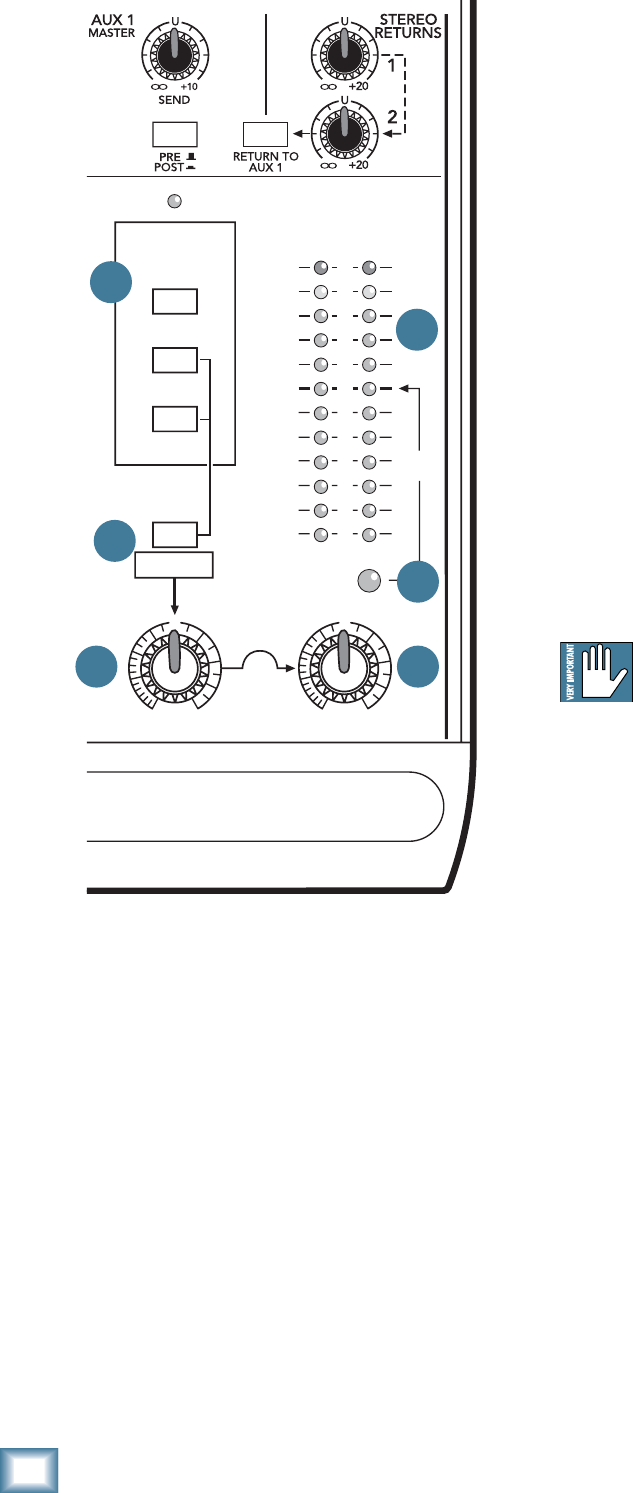
16
1202-VLZ3
1202-VLZ3
Output Section
33. CONTROL ROOM SOURCE MATRIX
Typically, the engineer sends the main mix to an
audience (if live) or a mixdown deck (if recording). But
what if the engineer in the control room needs to hear
something other than the main mix? With the 1202-
VLZ3, the engineer has several choices of what to listen
to. This is one of those tricky parts, so brace yourself.
Via these SOURCE switches, you can choose to listen
to any combination of main mix, ALT 3-4 and Tape. By
now, you probably know what the main mix is. ALT 3-4 is
that additional stereo mix bus. Tape is the stereo signal
coming in from the TAPE INPUT [9] jacks.
Selections made in the source matrix deliver stereo
signals to the control room, phones and meter display.
With no switches engaged, there will be no signal at
these outputs and no meter indication.
The exception is the solo function. Regardless of
the source selection, engaging a channel’s SOLO [24]
switch will replace that selection with the solo signal,
also sent to the control room, phones and right meter
(the left meter becomes inactive). This is what makes
the Level-Setting Procedure so easy to do.
WARNING: Engaging both the TAPE and
ASSIGN TO MAIN MIX [36] buttons can
create a feedback path between TAPE INPUT
[9] and TAPE OUTPUT [10]. Make sure your tape deck
is not in record, record-pause, or input-monitor mode
when you engage these switches, or make sure the CON-
TROL ROOM / SUBMIX 34] level knob is fully counter-
clockwise (off).
Now you know how to select the signals to send to the
engineer’s control room or phones. From there, these
signals all pass through the same level control:
34. CONTROL ROOM/SUBMIX
This knob controls the levels of both the stereo CON-
TROL ROOM [15] and PHONES [12] outputs. The con-
trol range is from off through unity gain at the detent,
with 10 dB of extra gain (when turned fully clockwise).
When MAIN MIX is your control room source selec-
tion, those signals will now pass through two level con-
trols on the way to your control room amp and phones
— the MAIN MIX [32] knob and this CONTROL ROOM
/ SUBMIX knob. This way, you can send a nice healthy
level to the main output (MAIN MIX knob at “U”), and
a quiet level to the control room or phones (CONTROL
ROOM / SUBMIX knob wherever you like it).
When ALT 3-4 or TAPE is selected, or SOLO [24] is
engaged, the CONTROL ROOM / SUBMIX knob will be
the only one controlling these levels (channel controls
not withstanding).
32. MAIN MIX
This knob controls the levels of signals sent to the
main outputs: XLR [13] and 1⁄4" [11] and RCA TAPE
OUTPUT [10]. All channels and STEREO RETURNS [7]
that are not muted or turned fully down will wind up in
the main mix.
Fully counterclockwise is off, the center detent is
unity gain, and fully clockwise provides 12 dB of addi-
tional gain. This additional gain will typically never be
needed, but once again, it’s nice to know it’s there. This
is the knob to turn down at the end of the song when
you want The Great Fade-Out.
CAUTION
POWER
RUDE
SOLO
LIGHT
LEVEL
SET
CONTROL
ROOM
SOURCE
ALT 3
–
4
TAPE
MAIN MIX
CLIP
LEFT RIGHT
0dB=0dBu
A
SSIGN
SSIGN
TO
TO
MA
MA
IN M
IN MIX
MAIN MIX
/SUBMIXCTL ROOM
MAX
OO
U
+12dB
OO
U
20
10
7
4
2
0
2
4
7
10
20
30
32
33
34
35
36
37


















